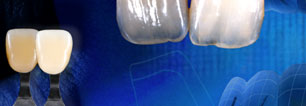- Deutsch|
- English


Prevention / Bleaching
Oral Hygiene, Plaque, Colouring, Cleansing, Tartar and Concrement removal, Ultrasound, and Bleaching in Frankfurt
Dental prophylaxis is designed to prevent or hinder tooth and oral disease.
Professional teeth cleaning is an essential part of dental prevention, which involves a far more thorough cleaning than patients can achieve themselves in their daily routine.
Plaque consists of a number of complex layers that contain protein, carbohydrate, phosphate and micro-organisms, and occurs particularly in on surfaces which cannot be easily cleaned naturally or reached by a toothbrush.
The primary purpose of preventative care is to create an environment which is as free as possible from plaque and tartar, and this requires specialist work. The long-term effectiveness of previous dental work (mostly fillings) is dependent on good oral hygiene. Everyone ought to visit their dentist every 6 months for a Scale and Polish, on top of carrying out the normal teeth cleaning everyone can do at home.
The clearing that takes place at the dentist’s involves removing hidden soft and hardened deposits, which are called “plaque” on the visible parts of the teeth and “mineralised plaque” under the gums. This is carried out using ultrasound and other instruments (polishing strips, brushes and floss). Afterwards any remaining discolouration or deposits can be removed using a mild abrasive and protective paste. This makes the surface of the teeth smooth and so hinders the build-up of plaque. Finally the tooth enamel is protected by treating it with a special fluoride solution.

Prevention / Bleaching
Healthy gums (Gingiva). Professional Teeth Cleaning, Plaque, Concrements, Prevention of periodontitis, lighter teeth, Bleaching
The purpose of bleaching is to make teeth look brighter and lighter, mostly for cosmetic or aesthetic reasons. Astonishing changes in the appearance of teeth are possible.
In the event that bleaching does not achieve the hoped for results, owing to extreme discolouration, teeth can be covered with veneers. (see Aesthetics · Veneers · Composite)
Discolouration can be caused externally by coloured foodstuff and drink (e.g., alcoholic drinks, tea, tobacco, coffee) getting into the teeth through cracks in the enamel. It can be caused internally as side-effects from medicines, or as a consequence of accidents, caries, morbidity of dental pulp, or malnutrition.
In-Office-Bleaching
This treatment is carried out in the dentist’s chair by me or one of my assistants. At first the gum is covered by a flexible “gingiva protector”. The bleach is then applied to the relevant teeth and rubbed in. Its effects are accelerated by applying a strong light. After 10-20 minutes the gel is removed. If the effect is not sufficient the process can be repeated. If bleaching is being done for the first time then normally only one or two treatments are required to create a long-lasting result.
We much prefer the “in-office-bleaching” as patients should not swallow any of the bleaching agent.
Walking-Bleach-Technique
If a dead tooth needs to be lightened it can be done with an inlay. The crown can be opened up again (it will have once been opened up for the root canal treatment) and filled with an appropriate bleaching agent, which will be left in the tooth for a few days (the tooth will be sealed temporarily). After the bleaching has taken place the space will be filled with colour-matching composite (see Aesthetics · Veneers · Composite). If the effect is not sufficient the process can be repeated.
It has been known for some years that cleaning teeth immediately after ingesting acidic foods or certain fruit juices (like pineapple and orange) can lead to damaged tooth enamel and gums. We therefore recommend waiting until saliva has neutralised the acid. Chewing gum can significantly speed up this process of neutralisation.

